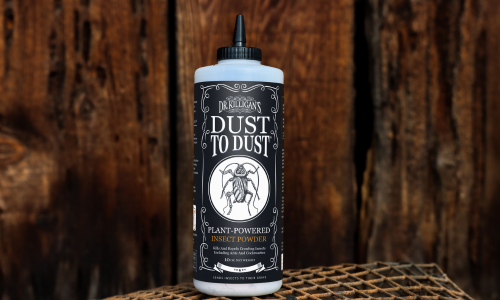Discovering a long, leggy pest darting across your floor can unsettle even the most stoic homeowner. Among these eerie invaders, house centipedes and silverfish stand out due to their peculiar appearances. Despite their similarities, understanding the key distinctions between these two pests is crucial for effective home pest control. Here, we’ll explore the differences between silverfish and centipedes and offer Dr. Killigan's solutions for keeping them at bay.
What house centipedes and silverfish look like
Size and body shape:
- Centipedes: Reach lengths up to 1½ inches, characterized by elongated, segmented bodies that give them a distinctly striped appearance, making them look more formidable.
- Silverfish: Smaller in size, usually only about ½ inch long, with unique flattened bodies that are broader and taper towards the rear, resembling a teardrop.
Color:
- Centipedes: Typically display a yellowish-brown coloration, with their bodies banded vertically with darker shades of brown, adding to their segmented appearance.
- Silverfish: Range from pale to dark gray, often with a metallic sheen that makes them appear shiny under light, lacking the visible bands or stripes found in centipedes.
Number of legs:

- Centipedes: Boast an impressive array of leg pairs, with the common house centipede featuring sixteen pairs, one pair per body segment, contributing to their swift movements.
- Silverfish: Have only three pairs of legs, positioned near the head, which are much shorter and less noticeable compared to the multitude of legs found on centipedes.
Antennae:
- Centipedes: Possess a pair of long antennae at their head, which they use for navigation and sensing their environment, a common trait among many arthropods.
- Silverfish: Not only have a pair of long antennae but also feature three long, unjointed limbs extending from the rear of their abdomen, giving the appearance of additional antennae, which aid in moisture detection and escape from predators.
How to keep centipedes and silverfish out
Understanding how pests infiltrate homes is the first step in maintaining a pest-free environment. Silverfish, with a penchant for high humidity, gravitate towards basements and bathrooms, while centipedes, attracted to damp areas, may find leaky pipes and basements appealing. To prevent these unwelcome visitors, consider the following preventive measures:
- Seal small cracks and gaps in the home’s exterior, including around windows, doors, and foundation walls to block entry points.
- Ensure windows, doors and vents are properly sealed and screened to deter pests.
- Address moisture issues by fixing leaky pipes and using dehumidifiers in damp areas like basements and bathrooms to create an inhospitable environment for moisture-loving pests.
- Regularly inspect items like books, furniture and plants before bringing them indoors to avoid introducing pests hidden within.
- Maintain tidiness in outdoor areas by removing vegetation close to the home and managing woodpiles and debris, which can offer shelter to pests.
How to defend against centipedes and silverfish with Dr. Killigan's
Following the preventative measures, Dr. Killigan's enhances your defense with active solutions that you can implement today - for any pest crawling about.
Dr. Killigan's Six Feet Under Plant-Powered Insect Spray:This non-toxic spray kills on contact and continues to protect for up to 30 days, boasting the fastest kill times among competitors. Ideal for floors, entry points and other bug-prone areas, Six Feet Under provides a proactive defense against pests.
For combating silverfish and centipedes, spray directly onto these pests and in areas where they are frequently observed. The spray's residual effect will continue to deter any new pests from entering these areas.
Dr. Killigan's Dust to Dust Plant-Powered Insect Powder:
Dr. Killigan's Dust to Dust combines fine silica particles with nano-tech essential oils for a dual-action formula. The microscopic edges of the silica particles dehydrate silverfish and centipedes by penetrating their exoskeletons, while the essential oils offer prolonged effectiveness through protected delivery. Ideal for indoor and outdoor use, it serves as both a preventive shield and a defense during invasions, ensuring residual protection around your home's perimeter or at the infestation source.
For combating silverfish and centipedes, deploy the Insect Buster to evenly apply a thin layer of powder across areas frequently visited by these pests. It's essential to regularly check these spots and reapply Dust to Dust as necessary, particularly in high-traffic zones, maintaining a continuous barrier that ensures their swift demise.
Dr. Killigan's Insect Buster Bulb Duster:Perfect for applying Dr. Killigan's Dust to Dust, the Insect Buster ensures precise, mess-free application in easy and hard-to-reach areas where centipedes and silverfish gather and hide. It offers a mess-free and precise way to disperse non-toxic insect powders.
Act now: Secure your sanctuary against centipedes and silverfish
By integrating Dr. Killigan's premium solutions into your pest management routine, you not only tackle silverfish and centipedes head-on but also protect your space with safety and efficiency in mind. Don't wait for the pests to make the first move. Strengthen your home’s defenses, maintain vigilant inspection practices, and deploy Dr. Killigan's arsenal where it counts. With these steps, you're not just combating pests; you're safeguarding your peace of mind and ensuring your home remains a sanctuary, free from the worry of uninvited guests. Take action today and enjoy the tranquility of a pest-free home tomorrow.










